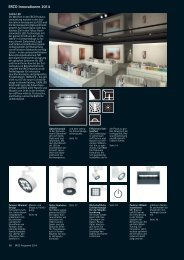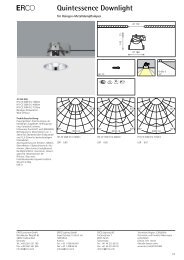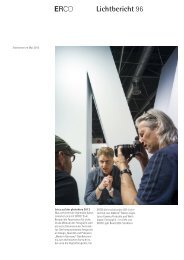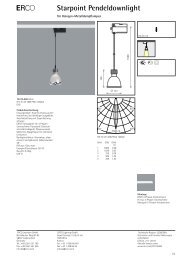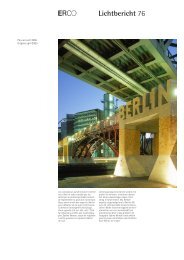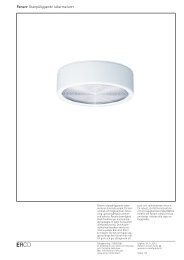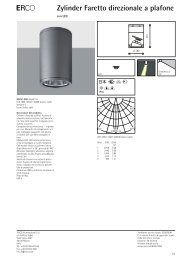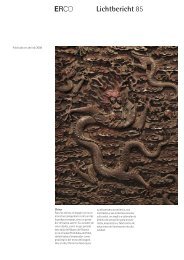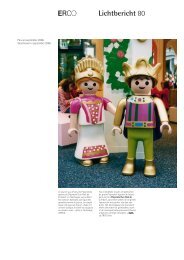ERCO Lichtbericht 94
ERCO Lichtbericht 94
ERCO Lichtbericht 94
Create successful ePaper yourself
Turn your PDF publications into a flip-book with our unique Google optimized e-Paper software.
LED spotlights with RGBW varychrome technology<br />
Products with RGBW technology<br />
The new LED varychrome technology<br />
for spotlights consists of the<br />
RGBW module, a special LED optical<br />
system with integrated colour<br />
mixing layer, a six-fold collimator,<br />
interchangeable Spherolit lenses,<br />
and customised DALI control gear.<br />
It is available in the new Light<br />
Board and Opton spotlight ranges<br />
and in the latest generation of<br />
Cantax spotlights. For ceiling integration,<br />
<strong>ERCO</strong> provides Light Board<br />
as recessed RGBW luminaires.<br />
RGBW technology now also features<br />
in LED downlights and LED<br />
wallwashers in the Quintessence<br />
range.<br />
Control of RGBW spotlights<br />
The lighting control system Light<br />
System DALI provides two control<br />
panels for corresponding spotlights<br />
in its integrated Light Studio<br />
software – the colour circle, which<br />
allows selection of any colour,<br />
and the slider control to regulate<br />
the whites of a defined colour<br />
temperature. In accordance with<br />
the current DALI standards, <strong>ERCO</strong>’s<br />
varychrome spotlights with RGBW<br />
technology only require one DALI<br />
address despite having four colour<br />
channels. The proven colour compensation<br />
technology used in the<br />
factory ensures a high level of colour<br />
constancy and precision.<br />
16 <strong>ERCO</strong> <strong>Lichtbericht</strong> <strong>94</strong><br />
Cantax varychrome<br />
RGBW<br />
Light Board varychrome<br />
recessed luminaire<br />
0.8<br />
0.7 510<br />
0.6<br />
0.5 500<br />
y<br />
0.4<br />
0.3<br />
0.2<br />
0.1<br />
490<br />
527<br />
530<br />
Green<br />
480<br />
Blue<br />
White<br />
555<br />
575<br />
0.0<br />
465 380<br />
0.0 0.1 0.2 0.3 0.4<br />
x<br />
0.5 0.6 0.7 0.8<br />
Colour space<br />
Within the coloured area<br />
of the CIE diagram, the<br />
Planckian locus traces the<br />
whites of different colour<br />
temperatures – from<br />
bluish cool white to reddish<br />
warm white. RGBW<br />
technology produces<br />
both highly saturated colours<br />
and variable shades<br />
of white.<br />
Red<br />
600<br />
622<br />
780<br />
Light Board varychrome<br />
RGBW<br />
Colour temperature<br />
Light Clients with the<br />
varychrome RGBW attribute,<br />
such as those from<br />
the new LED varychrome<br />
spotlight range, allow the<br />
colour temperature to be<br />
adjusted continuously<br />
over a wide range in the<br />
Light Studio software.<br />
Alternatively, the familiar<br />
colour wheel can be used<br />
to select any light colour.<br />
Opton varychrome<br />
RGBW<br />
Spherolit lens for RGBW<br />
The new LED varychrome spotlights<br />
feature a special form of the<br />
patented Spherolit lens technology<br />
developed by <strong>ERCO</strong>. The LED<br />
modules with their primary lenses<br />
directly on the LEDs, the collimators<br />
as secondary lenses to create<br />
a parallel beam, and the Spherolit<br />
lenses as tertiary lenses to control<br />
the light distribution are comple-<br />
Spectrum and colour rendition<br />
Due to the properties of the human<br />
eye, light that appears white to us<br />
may have a very different spectral<br />
composition. This results in varying<br />
renditions of body colours which<br />
define the colour rendition quality<br />
in relation to a full-spectrum<br />
reference light. Because of their<br />
narrow-band spectrums, pure RGB<br />
luminaires produce white light<br />
100 B G R<br />
80<br />
60<br />
40<br />
20<br />
0<br />
%<br />
300<br />
RGB LEDs<br />
The RGB LEDs are ideal for<br />
mixing highly saturated<br />
coloured light. However,<br />
the white light from RGB<br />
LEDs does not give satisfactory<br />
colour rendition<br />
quality, making it less<br />
suitable for lighting tasks<br />
where colour is critical.<br />
400 500 600 700 800 nm<br />
mented by a further layer: this<br />
colour mixing layer is positioned<br />
between LED module and the sixfold<br />
collimator for totally mixed<br />
homogeneous colour components<br />
in the optical system to produce a<br />
beam without any colour shadows.<br />
with poor colour rendition characteristics.<br />
The more uniform spectrum<br />
of the RGBW luminaires, in<br />
contrast, enables a highly natural,<br />
superior colour rendition.<br />
100 B G R<br />
80<br />
60<br />
40<br />
20<br />
0<br />
%<br />
300<br />
RGBW LEDs<br />
Mixing RGB LEDs with<br />
warm white LEDs combines<br />
the advantages<br />
of both systems: RGBW<br />
lumi naires produce variable<br />
shades of white<br />
along the Planckian curve<br />
with excellent colour<br />
rendering, but also coloured<br />
light in pastel hues<br />
all the way to the highly<br />
ww<br />
400 500 600 700 800 nm<br />
saturated range. The more<br />
uniform spectrum results<br />
in a good colour rendition<br />
quality.<br />
The optical components<br />
of <strong>ERCO</strong>’s LED varychrome<br />
spotlight with RGBW<br />
technology: RGBW LED<br />
module with primary lens<br />
(1), light mixing layer<br />
(2) with diffuser film (3),<br />
six-fold collimator as<br />
secondary lens (4), interchangeable<br />
Spherolit lens<br />
as tertiary lens (5).<br />
1<br />
2<br />
3<br />
4<br />
5<br />
<strong>ERCO</strong> <strong>Lichtbericht</strong> <strong>94</strong> 17



